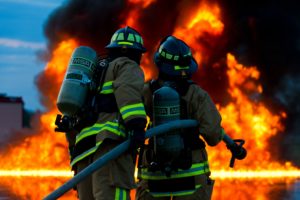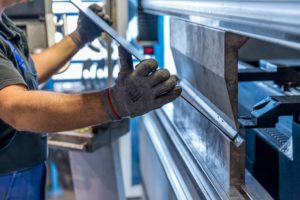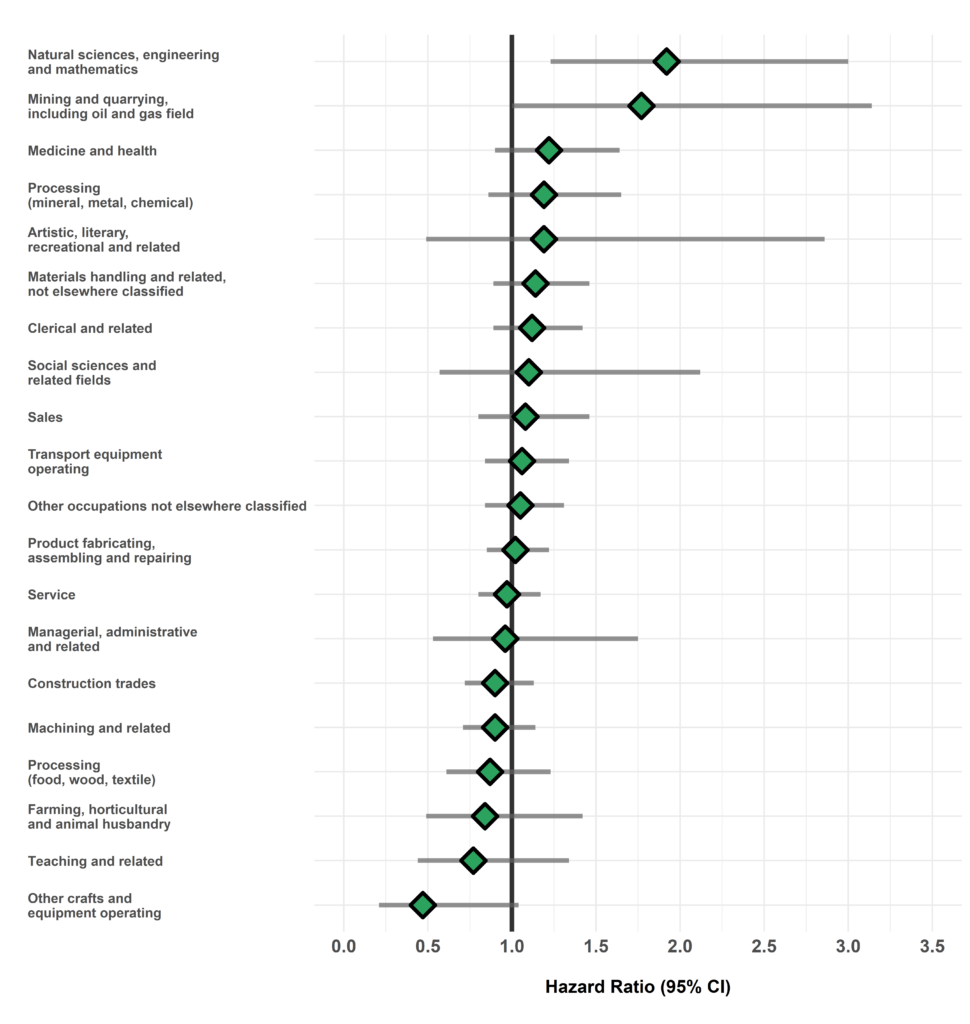Testicular Cancer
Background
Testicular cancer cases have been steadily increasing over the last several decades [1]. Approximately 1,200 Canadian men will be diagnosed with testicular cancer in 2022 [2]. Even though testicular cancer is rare, it is the most prevalent cancer in men aged 15 to 35 years [3].
Risk factors associated with testicular cancer include undescended testicle (cryptorchidism), family history of testicular cancer, personal history of testicular cancer, calcium deposits in the testicle, and tall adult height [1]. Occupational exposures, such as some pesticides and work as a firefighter, may also play an important role in the development of testicular cancer [1,4].
Possible occupational risk factors
-
- DDT (4,4′-dichlorodiphenyltrichloroethane) [4-5]
- N,N-Dimethylformamide [4]
- Occupational exposure as a firefighter [4,6-7]
- Perflurooctanoic acid (PFOA) [4]
Key Findings
Protective Services

Increased risk of testicular cancer was observed in firefighters and police in the ODSS. It is well documented that firefighters are exposed to various known and suspected carcinogens in fire and smoke [8]. Firefighters may have been exposed to PFOA, which was used in fire-fighting foam in the past [4]. Occupational exposures related to risk of testicular cancer in police is less understood. There is some evidence that microwave emissions from radar guns may be a risk factor due to the proximity of hand-held radar guns to the testicles [5,9-11].
-
- Protective service occupations- 1.46 times the risk
- Firefighters- 2.56 times the risk
- Policemen and detectives, government- 1.31 times the risk
- Protective service occupations- 1.46 times the risk
Product Fabrication and Manufacturing

Elevated risk of testicular cancer was observed in workers involved in aircraft manufacturing, assembly, and repair, which has been observed in previous studies [5,12-13]. Product fabrication and manufacturing occupations may have been exposed to PCBs present in older electrical products and equipment manufactured prior to the 1977 ban on PCB, as the legislation allowed for continued use of PCB equipment until the end of its service life [14]. Electrical product industry workers may have been exposed to PCBs through handling electrical equipment and cable insulation [14-16]. Construction workers in power lighting and wire communications may have been exposed to materials containing PCBs, such as electrical equipment, cable insulation, and adhesives [14-16], and PFOAs, found in electrical wire casing [17]. Workers in other product fabricating, assembling, and repairing occupations may have been exposed to PCBs through oils used in motors and hydraulic systems [14-16]. There is also limited evidence for exposure to hydrocarbon carcinogens and glycol ethers in aircraft handling occupations [5,12-13].
-
- Product fabricating, assembling, and repairing occupations- 1.15 times the risk
- Fabricating and assembling, metal products, not elsewhere classified – 1.46 times the risk
- Motor vehicle fabricating and assembling, not elsewhere classified- 1.43 times the risk
- Aircraft fabricating and assembling, not elsewhere classified- 1.85 times the risk
- Industrial, farm, construction and other mechanized equipment and machinery fabricating and assembling, not elsewhere classified- 1.62 times the risk
- Inspecting, testing, grading, sampling, fabricating and assembling metal products, not elsewhere classified- 2.23 times the risk
- Transportation equipment industries- 1.28 times the risk
- Aircraft and aircraft parts manufacturers- 1.43 times the risk
- Railroad rolling stock – 2.13 times the risk
- Mechanic and repair occupations, except electrical- 1.27 times the risk
- Motor vehicle mechanics and repairmen- 1.29 times the risk
- Aircraft mechanics and repairmen- 2.02 times the risk
- Industrial, farm and construction machinery mechanics and repairmen- 1.39 times the risk
- Mechanics and repairmen, except electrical, not elsewhere classified- 1.38 times the risk
- Electrical products industries- 1.11 times the risk
- Communication and electronic equipment manufacturers- 1.64 times the risk
- Electrical power lighting and wire communications equipment erecting, installing, and repairing occupations- 1.26 times the risk
- Construction electricians and repairmen- 1.31 times the risk
- Metal shaping and forming occupations
- Forging – 2.09 times the risk
- Welding and flame cutting – 1.05 times the risk
- Fabricating and assembling, metal products, not elsewhere classified – 1.46 times the risk
- Product fabricating, assembling, and repairing occupations- 1.15 times the risk
Transportation

Increased risk of testicular cancer was observed in various transportation occupations and industries in the ODSS. Whole body vibration [18] and diesel engine exhaust [4,19] have been linked to other cancer sites and may be potential risk factors in transportation workers. However, there is a lack of evidence supporting associations of these exposures with testicular cancer.
-
- Transportation industries- 1.11 times the risk
- Air transport- 1.38 times the risk
- Moving and storage, used goods, uncrated- 1.70 times the risk
- Urban transit systems- 1.39 times the risk
- Other transportation- 2.03 times the risk
- Transportation industries- 1.11 times the risk
-
- Transport equipment operating occupations- 1.29 times the risk
- Motor transport operating – 1.33 times the risk
- Bus drivers- 2.07 times the risk
- Taxi drivers and chauffeurs- 3.13 times the risk
- Truck drivers- 1.21 times the risk
- Motor transport operating, not elsewhere classified- 1.61 times the risk
- Motor transport operating – 1.33 times the risk
- Transport equipment operating occupations- 1.29 times the risk
Relative Risk by Industry and Occupation
Figure 1. Risk of testicular cancer diagnosis among workers employed in each industry group relative to all others, Occupational Disease Surveillance System (ODSS), 1999-2020

The hazard ratio is an estimate of the average time to diagnosis among workers in each industry/occupation group divided by that in all others during the study period. Hazard ratios above 1.00 indicate a greater risk of disease in a given group compared to all others. Estimates are adjusted for birth year and sex. The width of the 95% Confidence Interval (CI) is based on the number of cases in each group (more cases narrows the interval).
Figure 2. Risk of testicular cancer diagnosis among workers employed in each occupation group relative to all others, Occupational Disease Surveillance System (ODSS), 1999-2020

The hazard ratio is an estimate of the average time to diagnosis among workers in each industry/occupation group divided by that in all others during the study period. Hazard ratios above 1.00 indicate a greater risk of disease in a given group compared to all others. Estimates are adjusted for birth year and sex. The width of the 95% Confidence Interval (CI) is based on the number of cases in each group (more cases narrows the interval).
Table of Results
Table 1. Surveillance of Testicular Cancer: Number of cases, workers employed, and hazard ratios in each industry (SIC)
| SIC Code * | Industry Group | Number of cases | Number of workers employed | Hazard Ratio (95% CI) † |
| 1 | Agriculture | 34 | 28403 | 0.81 (0.58-1.14) |
| 2/3 | Forestry, Fishing and Trapping |
6 | 10252 | 0.46 (0.21-1.03) |
| 4 | Mines, Quarries and Oil Wells |
25 | 24246 | 1.02 (0.69-1.51) |
| 5 | Manufacturing | 690 | 545155 | 0.98 (0.89-1.07) |
| 6 | Construction | 245 | 216708 | 0.89 (0.78-1.02) |
| 7 | Transportation, Communication and Other Utilities |
212 | 177059 | 1.14 (0.99-1.32) |
| 8 | Trade | 482 | 314398 | 1.12 (1.01-1.24)* |
| 9 | Finance, Insurance and Real Estate |
14 | 16336 | 0.83 (0.49-1.41) |
| 10 | Community, Business and Personal Service |
371 | 271710 | 1.03 (0.92-1.16) |
| 11 | Public Administration and Defense |
156 | 127829 | 1.21 (1.03-1.43)* |
| * SIC: Standard Industrial Classification (1970) | ||||
| † Hazard rate in each group relative to all others | ||||
Table 2. Surveillance of Testicular Cancer: Number of cases, workers employed, and hazard ratios in each occupation (CCDO) group
| CCDO Code * | Occupation Group | Number of cases | Number of workers employed | Hazard Ratio (95% CI) † |
| 11 | Managerial, administrative and related |
19 | 16805 | 1.71 (1.09-2.70)* |
| 21 | Natural sciences, engineering and mathematics |
31 | 22729 | 1.36 (0.96-1.95) |
| 23 | Social sciences and related fields |
5 | 7817 | 0.63 (0.26-1.52) |
| 25 | Religion | 0 | 64 | — |
| 27 | Teaching and related | 9 | 11761 | 1.04 (0.54-2.01) |
| 31 | Medicine and health | 22 | 19780 | 1.15 (0.75-1.75) |
| 33 | Artistic, literary, recreational and related |
11 | 9792 | 0.95 (0.52-1.71) |
| 41 | Clerical and related | 130 | 102632 | 1.03 (0.86-1.23) |
| 51 | Sales | 117 | 78714 | 1.05 (0.87-1.27) |
| 61 | Service | 286 | 204019 | 1.14 (1.00-1.29)* |
| 71 | Farming, horticultural and animal husbandry |
56 | 43001 | 0.91 (0.70-1.19) |
| 73 | Fishing, hunting, trapping and related |
0 | 547 | — |
| 75 | Forestry and logging | 9 | 10328 | 0.65 (0.34-1.25) |
| 77 | Mining and quarrying, including oil and gas field |
10 | 13358 | 0.75 (0.40-1.40) |
| 81 | Processing (mineral, metal, chemical) |
83 | 65388 | 1.00 (0.80-1.25) |
| 82 | Processing (food, wood, textile) |
77 | 70440 | 0.81 (0.65-1.02) |
| 83 | Machining and related | 212 | 173664 | 1.00 (0.86-1.15) |
| 85 | Product fabricating, assembling and repairing |
369 | 274701 | 1.15 (1.03-1.29)* |
| 87 | Construction trades | 256 | 227776 | 0.96 (0.84-1.10) |
| 91 | Transport equipment operating |
209 | 166522 | 1.29 (1.11-1.49)*** |
| 93 | Materials handling and related, not elsewhere classified |
171 | 128719 | 0.96 (0.82-1.12) |
| 95 | Other crafts and equipment operating |
32 | 23358 | 1.24 (0.88-1.77) |
| 99 | Other occupations not elsewhere classified | 259 | 183819 | 1.00 (0.88-1.14) |
| * CCDO: Canadian Classification Dictionary of Occupations (1971) | ||||
| † Hazard rate in each group relative to all others | ||||
Please note that ODSS results shown here may differ from those previously published or presented. This may occur due to changes in case definitions, methodological approaches, and the ongoing nature of the surveillance cohort.
References
- Canadian Cancer Society. Risk factors for testicular cancer [Internet].[cited 2022 Jun 6].
- Brenner DR, Poirier A, Woods RR, Ellison LF, Billette JM, Demers AA, Zhang SX, Yao C, Finley C, Fitzgerald N, Saint-Jacques N. Projected estimates of cancer in Canada in 2022. Can Med Assoc J. 2022 May 2;194(17):E601-07
- Testicular Cancer Canada [Internet].[cited 2022 Jun 6].
- International Agency for Research on Cancer (IARC). List of Classifications by cancer sites with sufficient or limited evidence in humans, IARC Monographs Volumes 1-127(2020).
- McGlynn KA, Trabert B. Adolescent and adult risk factors for testicular cancer. Nat Rev Urol. 2012 Jun;9(6):339-49
- Jalilian H, Ziaei M, Weiderpass E, Rueegg CS, Khosravi Y, Kjaerheim K. Cancer incidence and mortality among firefighters. Int J Cancer. 2019 Nov 15;145(10):2639-46
- Sritharan J, Kirkham TL, MacLeod J, Marjerrison N, Lau A, Dakouo M, Logar-Henderson C, Norzin T, DeBono NL, Demers PA. Cancer risk among firefighters and police in the Ontario workforce. Occup Environ Med. Epub ahead of print: Mar 2022
- International Agency for Research on Cancer. IARC monographs on the evaluation of carcinogenic risks to humans. Volume 98. Painting, Firefighting, and Shiftwork (2010)
- Stenlund C, Floderus B. Occupational exposure to magnetic fields in relation to male breast cancer and testicular cancer: a Swedish case-control study. Cancer Causes Control. 1997 Mar;8(2):184-91
- Floderus B, Stenlund C, Persson T. Occupational magnetic field exposure and site-specific cancer incidence: a Swedish cohort study. Cancer Causes Control. 1999 Aug;10(5):323-32
- Davis RL, Mostofi FK. Cluster of testicular cancer in police officers exposed to handheld radar. Am J Ind Med 1993;24(2):231–33
- Boice JD, Marano DE, Fryzek JP, Sadler CJ, McLaughlin JK. Mortality among aircraft manufacturing workers. Occup Environ Med. 1999 Sep 1;56(9):581-97
- Lipworth L, Sonderman JS, Mumma MT, Tarone RE, Marano DE, Boice Jr JD, McLaughlin JK. Cancer mortality among aircraft manufacturing workers: an extended follow-up. J Occup Environ. 2011 Sep 1;53(9):992-1007
- Health Canada. PCBs [Internet].[cited 2022 Jun 6].
- Mester B, Behrens T, Dreger S, Hense S, Fritschi L. Occupational causes of testicular cancer in adults. Int J Occup Environ Med (The IJOEM). 2010 Sep 21;1(4):160-70
- United States Environmental Protection Agency. Polychlorinated Biphenyls (PCBs) [Internet].[cited 2022 Jun 6].
- International Agency for Research on Cancer. IARC monographs on the evaluation of carcinogenic risks to humans. Volume 110. A review of human carcinogens. Some Chemicals Used As Solvents and In Polymer Manufacture (2017).
- Nadalin V, Kreiger N, Parent ME, Salmoni A, Sass-Kortsak A, Siemiatycki J, et al. Prostate cancer and occupational whole-body vibration exposure. Ann Occup Hyg. 2012;56(8):968–74.
- Rosenfeld PE, Spaeth KR, Hallman R, Bressler R, Smith GC. Cancer risk and diesel exhaust exposure among railroad workers. Water Air Soil Pollut 2022;233:171.
